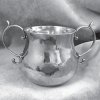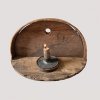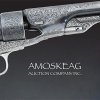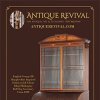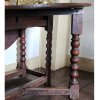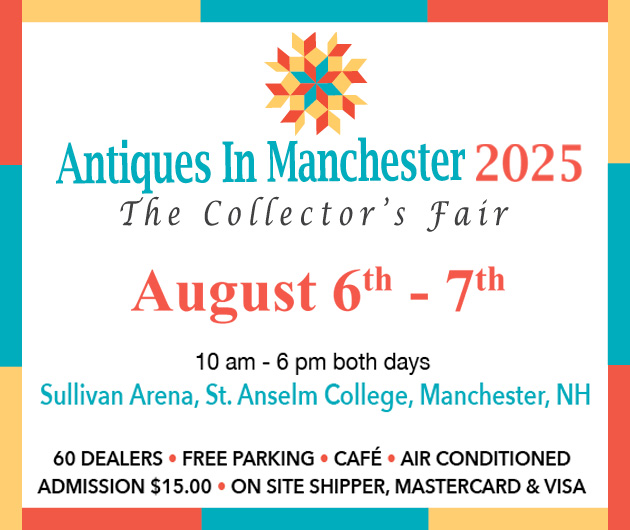Mittler Scrimshaw Blowout
October 15th, 2016
Robert C. Eldred Co., Inc., East Dennis, Massachusetts
Photos courtesy Eldred’s
It was just like the old days at Eldred’s sale on October 15, 2016, when a full house convened for the star attraction—the scrimshaw collection of Thomas Mittler. Marine art from the Newport, Rhode Island, estate of Robert Tiedemann and a Connecticut collection rounded out the offerings.
It was decidedly a marine crowd, and plenty of Nantucket red pants occupied seats in the gallery. It was an exciting sale, as lot after lot from the Mittler collection blew past estimates to resounding applause in the otherwise hushed gallery. Sixty Mittler lots were sold, all to collectors. Another 140 Mittler lots will sell in two future sales, one in the spring and the other in the summer marine sale.

This whale’s tooth by William Lewis Roderick is titled “In Shore Whaling The Death” and also engraved “The Tooth of a Sperm Whale Captured March 30th 1855.” It brought $180,000. Roderick was a Welsh physician who served as ship’s surgeon on three South Seas whaling voyages aboard the London-registered bark Adventure between 1847 and 1856. The tooth illustrates a whale ship, four whaling dories, one of which is staved in, with whalemen swimming around it, pursuing a pod of sperm whales near an island with a smoking volcano. The image is framed by engraved vines on one end and vines and a bird on the other. The carving is delicate and detailed; some hold Roderick as perhaps the most talented scrimshaw carver of all.
Mittler, a Michigan industrialist, was a passionate collector of sports cars and vintage wooden boats as well as scrimshaw. He began gathering scrimshaw after visiting an antiques show in 1969. His scrimshaw collection is regarded widely as the best to come on the market since the 1982 sale of the Barbara Johnson collection at Sotheby’s. The teeth Mittler collected were mostly from between 1830 and 1860. The artistry and skill involved in each engraving is impressive. What’s more, every tooth tells a story. As to the carvers, a few names are known, although with improved research techniques and resources, more and more are coming to light.
Each lot of the 60-lot collection is documented in Nantucket dealer Nina Hellman’s Through the Eyes of a Collector: The Scrimshaw Collection of Thomas Mittler, commissioned and published in Mittler’s honor by his widow, Charlotte G. Mittler. Hellman and her husband, Bob Hellman, had advised Mittler on his collection and were present for the sale.

This pair of polychrome whale’s teeth was attributed to Manuel Enos of Long Island, New York, known formerly as the Ship Java Artist. Enos was described by Dr. Stuart M. Frank, senior curator emeritus of the New Bedford Whaling Museum, in a 2009 article for the museum as one of the outstanding scrimshaw makers and arguably the greatest Azorean whaleman artist of all time. One tooth depicts a young woman with a garland of flowers beneath a vine of flowers, which was based on an image from a cover of the Family Circle and Parlor Annual. The other portrays two women in elaborate and colorful Victorian dress on a black-and-white checkered floor. The pair realized $120,000 in the gallery.
The Mittler collection was set originally to be sold at Northeast Auctions, but as Ron Bourgeault told M.A.D.: “It was time for another auction house to offer the Mittler scrimshaw collection, and I am delighted the family chose to use Eldred’s. Northeast Auctions worked with the Mittler collection for over three years, carefully following the discussion of proposed government guidelines for selling antiques made of endangered species. Over a year ago, I attended a symposium at Fordham University Law School on the subject and realized the guidelines had not yet been definitively formulated. It was a challenge for all of us—government, collectors, dealers, and auctioneers. And it was certainly understandable that it took time for the Fish and Wildlife Department to finalize their guidelines. At the same time, over the course of the three years we worked with the collection, the estate appraisal began to seem high, as many of the pieces were understandably appraised based on pre-2008 record sale prices. A year ago this May, we hosted a viewing of the Mittler collection for New Bedford Whaling Museum Scrimshaw Symposium participants, and it was a wonderful experience. Northeast Auctions will always feel we were a part of this great collection. It was just time for Eldred to take the collection with a fresh outlook.”
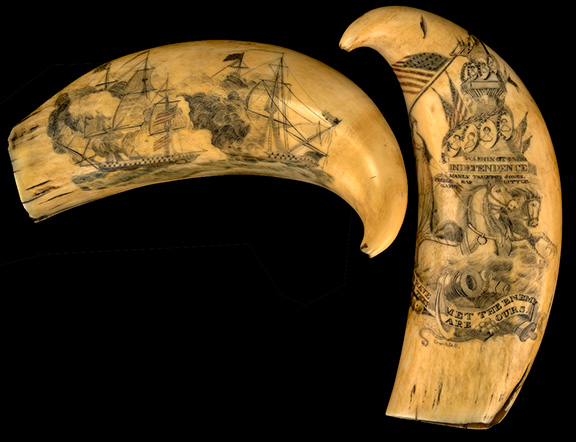
A pair of whale’s teeth from the first part of the 19th century brought $132,000. The polychrome example (right), signed “Campbell,” depicts Liberty on a shell drawn by two horses and holding a flag with a “Washington Independence” monument with a profusion of American flags and 12 oval vignettes of naval heroes. The other example is unsigned and depicts a naval battle between the Constitution and the Guerrière on one side and the Enterprise and the Boxer on the other.
As William Bourne, Eldred’s head of American and maritime arts, took the podium, the gallery settled into an expectant silence. The highlight of highlights was the whale’s tooth by William Lewis Roderick titled “In Shore Whaling The Death” and also engraved “The Tooth of a Sperm Whale Captured March 30th 1855.” Bidding opened at $30,000 and ended at $180,000 (includes buyer’s premium) when a determined phone bidder prevailed.
Roderick was a Welsh physician who served as ship’s surgeon on three South Seas whaling voyages aboard the London-registered bark Adventure between 1847 and 1856. Four whaling dories, one of which is shown staved in, pursue a pod of sperm whales. The image is framed by engraved vines on one end and vines and a bird on the other. The carving is delicate and detailed. Some hold Roderick as perhaps the most talented scrimshaw carver of all.
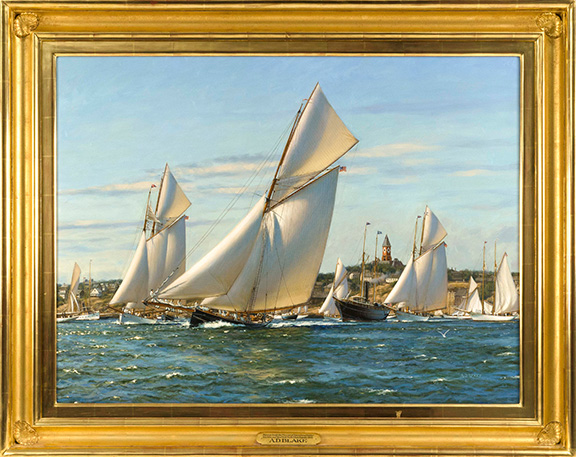
“Puritan” Leads the Fleet out of Marblehead Harbor heading for the Eastern and New York Yacht Club’s Regatta, 1892 is a contemporary oil on canvas, 30¼" x 40¼" depicting the yacht Puritan by Anthony D. Blake (b. 1951) of New Zealand. It sold for $18,000. Puritan was the victorious defender of the fifth America’s Cup race in 1885 against the British Genesta. The painting retains a label from Marine Arts Gallery, formerly in Salem, Massachusetts, now in Marblehead, and came from a Connecticut collection.
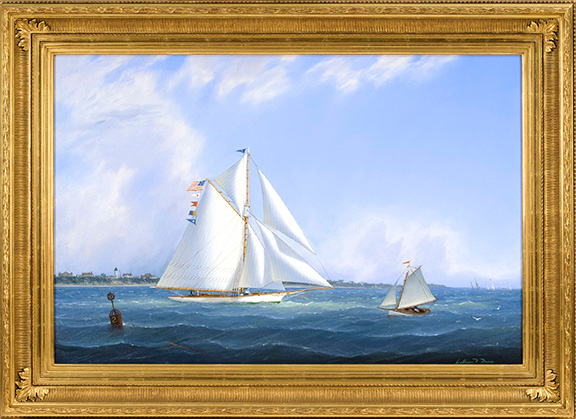
Summer Sailing off Chatham Light, a 24" x 36" oil on canvas by William R. Davis (b. 1952) of Cape Cod, brought $25,200. Passengers and crew are garbed in the fashion of the late 19th century.
 Collector Robert H. Tiedemann loved vintage yachts and everything about them. His holdings included paintings and photographs, models, silver, stationery from the yacht Constellation, and even yacht club china. A lot of six life rings from various yachts of the New York Yacht Club brought $1440. Among a group of half-hulls was a 19th-century builder’s model with eight lifts and the engraved plaque “Bourne & Kingsbury Builders” (referring to the southern Maine builders) that brought $2500. Tiedemann’s 14" x 24" oil on board portrait of the motor yacht Paula Louise by Miami African American artist Joe Selby (1893-1960), who painted portraits of yachts tied up at the docks in Miami, sold for $3750. Also from the Tiedemann collection was a 1916 watercolor and gouache portrait of the yacht Juniata, 11" x 19", that brought $4375. The 139'6" vessel was built in 1911 as the Josephine for Edward Shearson of New York and was sold in 1914 to George W. Elkins of Philadelphia, who renamed her. She was acquired by the Navy in 1917 and used as a section patrol boat in World War I and returned to Elkins in 1918.
Collector Robert H. Tiedemann loved vintage yachts and everything about them. His holdings included paintings and photographs, models, silver, stationery from the yacht Constellation, and even yacht club china. A lot of six life rings from various yachts of the New York Yacht Club brought $1440. Among a group of half-hulls was a 19th-century builder’s model with eight lifts and the engraved plaque “Bourne & Kingsbury Builders” (referring to the southern Maine builders) that brought $2500. Tiedemann’s 14" x 24" oil on board portrait of the motor yacht Paula Louise by Miami African American artist Joe Selby (1893-1960), who painted portraits of yachts tied up at the docks in Miami, sold for $3750. Also from the Tiedemann collection was a 1916 watercolor and gouache portrait of the yacht Juniata, 11" x 19", that brought $4375. The 139'6" vessel was built in 1911 as the Josephine for Edward Shearson of New York and was sold in 1914 to George W. Elkins of Philadelphia, who renamed her. She was acquired by the Navy in 1917 and used as a section patrol boat in World War I and returned to Elkins in 1918.
The “Mohawk” and the “Dauntless” off Sandy Hook, a 22" x 34" oil on canvas by James Edward Buttersworth, was previously unknown and depicted the race between two yachts of the New York Yacht Club in 1875. Estimated at $250,000/350,000, it passed.
For information, check the website (www.eldreds.com) or call (508) 385-3116.
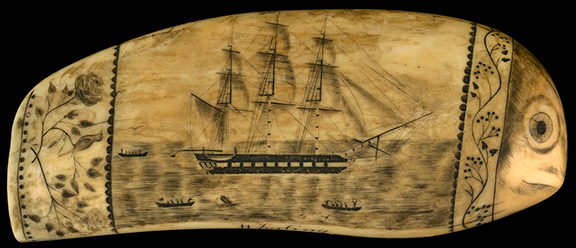
A tooth by the Lady Wellington Engraver depicts a whale ship, three whaleboats, and four whales, one of which is marked with a waif (flagged pole) on one side. The other side of the tooth states “At Anchor” and depicts a whale ship flying the British flag with two whaleboats approaching the ship. The tooth has two bands of botanical decorations. The top band encircles the tooth with berry and foliate vines, above which is the face of a fish. The tooth fetched $54,000.
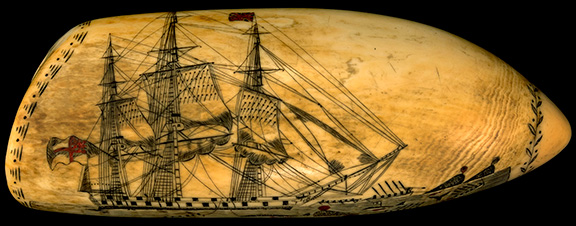
A polychrome whale’s tooth by the Britannia Engraver has “Daniel, the, Fourth, London, Elizabeth” and images of the whale ships Daniel of London and the Elizabeth. The reverse depicts a whaling scene of the Daniel, five whaleboats, and six visible whales, one of which is marked with a waif. Red sealing wax was applied to the pennants, flag, whale spouts, and the flames of Daniel afire. The Britannia Engraver has not yet been identified, except as British. This tooth brought $54,000 from the same phone bidder who bought the Roderick tooth and several other teeth.
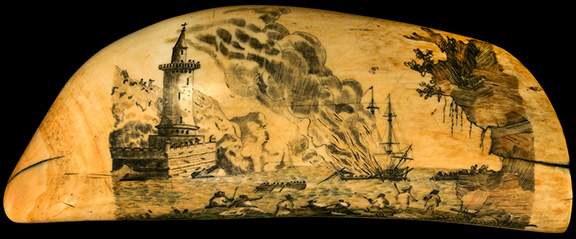
This large polychrome tooth tells the story of the burning of the U.S.S. Philadelphia in Tripoli harbor in 1804 by Lieutenant Stephen Decatur, who set it afire after its capture by the Barbary pirates to prevent them from using the ship. Armed onlookers wave weapons on shore as boats filled with men row away from the vessel. The other side depicts a warship off the coast and additional ships in the distance. The highly detailed scenes are separated by a floral vine border. The tooth realized $78,000 from a persistent phone bidder who bought several important lots.
Originally published in the January 2017 issue of Maine Antique Digest. © 2016 Maine Antique Digest




